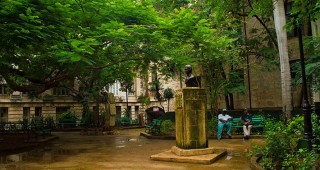
This scale model of Havana is the third largest scale model in the world. It was built at a scale of 1:1000 and spans over 144 square meters. It is approximately 22 meters long and 10 meters wide and weighs six tons. A team of nine designers, model makers and architects led by Orlando Martorell worked for eleven years to build a detailed model of the Cuban capital mostly out of Habano cigar boxes, cardboard, sponge, plastic and sand. In order to give the visitor an idea of the constructive evolution of the city, the buildings are displayed through the use of different colors–brown for the colonial period, i.e. until 1898; ochre for the Republican period, from 1902 to 1959; ivory for the revolutionary period to the present day; and white for projects, sculptural monuments and cemeteries.
Buildings are made out of recycled cigar boxes and colour codes are used to indicate the different historical periods: ochre for the colonial era (16th-19th centuries), yellow for the Republic (1900-58) and cream for post-Revolutionary developments. The model is the work of the Comprehensive Development of the City Group, which has advised city officials on urban planning since 1987. Insightful guided tours are available in English; they are well worth the extra cost, particularly for groups.
Maqueta de la Habana – Better than a map By Victoria Alcalá
Scale models are used all over the world in architecture, research and urban planning. They provide not only the appearance of cities in the past but also what our surroundings look like today or will look like in the future. They are useful tools for engineers and architects in developing cities. These miniature cities, however, are not only functional; they can become true works of art if they are built with great attention to detail to achieve the simulation of an actual dimension. The detail is such that the scale model of a city displays from the smallest or narrowest street to water tanks on rooftops.
There are many scale models of cities the world over, like the ones in Moscow, Stockholm, Tokyo, London, Quebec City, New York and Shanghai, the latter two being the largest and second largest scale models in the globe, respectively, while our own scale model of Havana ranks third. It was built at a scale of 1:1000 and spans over 144 square meters (1,550 sq ft) which is equal to 144 sq km. It is approximately 22 meters long and 10 meters wide and weighs six tons.
A team of nine designers, model makers and architects led by Orlando Martorell worked for eleven years to build a detailed model of the Cuban capital mostly out of Habano cigar boxes, cardboard, sponge, plastic and sand.
The careful study of each place, deft fingers, creativity and the perseverance of these specialists from the Group for the Integrated Development of Havana guided the patient work of reproducing a city inside a room that was especially designed for that purpose. The spacious room is surrounded by a ramp that allows an aerial or panoramic view of the scale model. The visitor can take a closer look at the city as a whole or locate a particular building or street thanks to binoculars that are placed on the ramp.
For those who know the city, searching with the binoculars becomes a game or a bet to locate specific places or addresses, and no one escapes the temptation of finding their house in the midst of the intricate urban fabric. Those who visit the scale model for the first time discover the magical universe of its constructive mix: the tropicalized 18th-century Baroque reflected in the beautiful churches and mansions in the Historic Center; the 19th-century neoclassicism with outstanding examples in the area around the former city walls; the grand architectural movements of the 20th century; the omnipresent eclecticism scattered practically all around city; the beautiful and sensual art nouveau; the very popular art deco which can be seen both in magnificent constructions like the Bacardí Building and in modest homes; the modern movement, clearly expressed in the “skyscrapers” of the Vedado district and the sophisticated residences of Miramar; the eastward expansion that began in 1959; the splendid National Art School, and so much more. Summing it up, the “the styleless style” of the metropolis that Alejo Carpentier called “the city of columns”.
In order to give the visitor an idea of the constructive evolution of the city, the buildings are displayed through the use of different colors–brown for the colonial period, ie until 1898; ochre for the Republican period, from 1902 to 1959; ivory for the revolutionary period to the present day; and white for projects, sculptural monuments and cemeteries.
The scale model of Havana is not only useful for further studying the urban projection of a city that never stops growing, but also as a tourist attraction. No wonder it is visited by so many people, both nationals and visitors from other countries. So, if you’re in town for the first time, it is strongly recommended that you stop by the Maqueta de La Habana, which is a good start to understand the dynamics of the Cuban capital, and surely, better than a map.















 Modern
Modern





